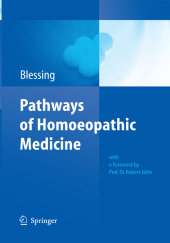 Neuerscheinungen 2014Stand: 2020-02-01 |
Schnellsuche
ISBN/Stichwort/Autor
|
Herderstraße 10
10625 Berlin
Tel.: 030 315 714 16
Fax 030 315 714 14
info@buchspektrum.de |

Bettina Blessing
Pathways of Homoeopathic Medicine
2011. 2014. x, 105 S. 240 mm
Verlag/Jahr: SPRINGER, BERLIN; SPRINGER BERLIN HEIDELBERG 2014
ISBN: 3-642-43873-3 (3642438733)
Neue ISBN: 978-3-642-43873-8 (9783642438738)
Preis und Lieferzeit: Bitte klicken
Pathways of Homoeopathic Medicine studies the progress of homeopathic therapies up to World War II. The volume presents the development of double and complex remedies, and explores how homoeopathy, spagyric, naturopathy and conventional medicine supported medical concepts based on ´holistic´ views.
Bettina Blessing´s study follows the progress of homoeopathic therapies up to World War II. It focuses mainly on the development of double and complex remedies which were highly controversial even at the times of Hahnemann, who also experimented with double remedies. Various orientations of homoeopathy, spagyric, naturopathy and conventional medicine advocated homoeopathic remedies and supported medical concepts that were based on ´holistic´ views. One of the proponents of alternative healing methods was the renowned Berlin surgeon August Bier (1861-1949). For him, homoeopathy was one of several possible medical approaches and, in accordance with Heraclitus, he argued that a ´harmonious view´ of medicine was not possible as long as one of them was excluded.
Foreword
1 The Development of Complex Homoeopathy from the 19th Century to the End of the Weimar Republic
The controversy about the double remedy during Hahnemann´s lifetime
Arthur Lutze´s views on drug mixtures
Complex remedies in Europe
The Central Homoeopathic Association
"What attitude should we have towards complex homoeopathy?"
Single remedy homoeopathy
Complex remedies as a compromise
Clinical homoeopathy
The dissemination of complex homoeopathy
Felke
Madaus
Reckeweg
Hense
Zähres
Schwabe
Pascoe
Excursus: spagyrics
Electro-homoeopathy
Mattei
Sauter
Zimpel
Krauss
Sonntag
2 The Connection Between Homoeopathy and Naturopathy
Naturopathy
Pathological concepts
Emanuel Felke and his therapeutic concept: homoeopathy and naturopathy
Felke´s pathological concept
Felke´s healing approach
Sitzbaths
Light-, air- and sun baths
Clay therapy
Nutrition and exercise
Hahnemann´s dietetics
Syntheses of the healing methods
3 Homoeopathy as Part of a "Holistic Medicine"
The ´crisis´ of orthodox medicine
August Bier (1861-1949)
August Bier´s attitude towards homoeopathy
Ferdinand Sauerbruch: "Taking up the cudgels for August"
Conflicts of interest
The similarity principle
Drug Proving
Posology
Hahnemann´s homoeopathy as a system
August Bier and the "world´s biggest natural healing institute"
Establishing homoeopathy at the University of Berlin
Hans-Heinrich Reckeweg´s pathology and therapy concept
Fever and inflammation
Phases of poisoning
Homoeopathy and homotoxicology
Injection therapy with homoeopathic remedies
Nutrition and sutoxins
Homoeopathy as the "mother of medicine"
4 Summary
5 Archives
6 Bibliography


